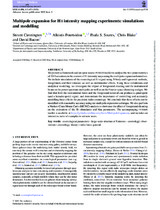| dc.contributor.author | Pourtsidou, Alkistis | |
| dc.contributor.author | Cunnington, Steven | |
| dc.contributor.author | Soares, Paula S. | |
| dc.date.accessioned | 2021-02-08T10:24:23Z | |
| dc.date.available | 2021-02-08T10:24:23Z | |
| dc.date.issued | 2020 | |
| dc.identifier.citation | Pourtsidou, A. et al. (2020). Multipole expansion for H I intensity mapping experiments: simulations and modelling. Monthly Notices of the Royal Astronomical Society, 496(1), 415–433, | en_US |
| dc.identifier.issn | 1365-2966 | |
| dc.identifier.uri | https://doi.org/10.1093/mnras/staa1524 | |
| dc.identifier.uri | http://hdl.handle.net/10566/5854 | |
| dc.description.abstract | We present a framework and an open-source PYTHON toolkit to analyse the two-point statistics of 3D fluctuations in the context of H I intensity maps using the multipole expansion formalism. We include simulations of the cosmological H I signal using N-body and lognormal methods, foregrounds and their removal, as well as instrumental effects. Using these simulations and analytical modelling, we investigate the impact of foreground cleaning and the instrumental beam on the power spectrum multipoles as well as on the Fourier space clustering wedges. We find that both the instrumental beam and the foreground removal can produce a quadrupole (and a hexadecapole) signal, and demonstrate the importance of controlling and accurately modelling these effects for precision radio cosmology. | en_US |
| dc.language.iso | en | en_US |
| dc.publisher | Oxford University Press | en_US |
| dc.subject | Cosmological parameters | en_US |
| dc.subject | Large-scale structure of Universe | en_US |
| dc.subject | Cosmology: observations | en_US |
| dc.subject | Cosmology: theory | en_US |
| dc.subject | Radio lines: general | en_US |
| dc.title | Multipole expansion for H I intensity mapping experiments: simulations and modelling | en_US |
| dc.type | Article | en_US |

